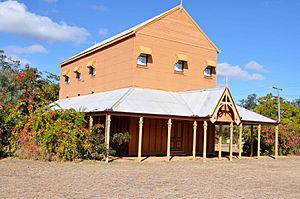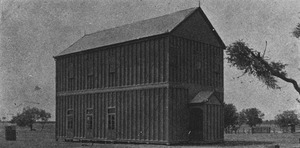Blackall Masonic Temple facts for kids
Quick facts for kids Blackall Masonic Temple |
|
|---|---|

Blackall Masonic Temple, 2011
|
|
| Location | Hawthorn Street, Blackall, Blackall-Tambo Region, Queensland, Australia |
| Design period | 1900 - 1914 (early 20th century) |
| Built | 1908 |
| Official name: Blackall Masonic Temple | |
| Type | state heritage (built) |
| Designated | 21 October 1992 |
| Reference no. | 600032 |
| Significant period | 1908 (fabric) |
| Significant components | dais, objects (movable) - social/community, furniture/fittings |
| Lua error in Module:Location_map at line 420: attempt to index field 'wikibase' (a nil value). | |
The Blackall Masonic Temple is a historic building in Blackall, Queensland, Australia. It was built in 1908 and is a special type of meeting place called a masonic temple. It's located on Hawthorn Street and is recognized for its importance by being on the Queensland Heritage Register.
Contents
History of the Temple
This Masonic temple is the second one built in the Blackall area. It was finished in 1908.
What is Freemasonry?
Freemasonry is one of the oldest social and charitable organizations in the world. Its members, called Freemasons, meet in local groups called lodges. They focus on personal improvement, friendship, and helping others. Freemasonry first came to Queensland from New South Wales in 1859. As more towns grew, new lodges were formed.
Freemasonry in Blackall
Blackall became a town in 1868. It was an important center for the surrounding sheep and cattle stations. In May 1887, a group of seven Freemasons met in Blackall to start their own lodge. By the end of that year, they had 32 members!
Their first meeting place was a brick building on Short Street. This building was owned by James McKenzie, one of the first new members. The lodge used this building until 1905 or 1906. The owner then needed the building for other things, and it was later taken down in 1958.
For a short time, the lodge met in the old Government Lands Office. But this wasn't very handy. So, the members decided to build a brand new temple. A.E. Hewer, R.E. Burton, and J.H. Hart gave one acre of land on Hawthorne Street for the new building.
A two-story building was put up on the land. Many of the furniture pieces still used today were given by A.H. Whittingham. The new temple was officially opened in May 1908. This was exactly 21 years after the lodge first started. The building cost about £1603, which included connecting it to gas and running water.
Life as a Freemason in Blackall
Many lodge members were important people in town. Others were managers or overseers from big stations far away. Attending meetings was a big effort for them. They often had to travel long distances on rough roads.
Being part of Freemasonry was very important for men living in isolated areas. It offered friendship and a sense of community. Lodges also held social events and helped local charities. They gave local business people a chance to meet. All of this helped the town of Blackall grow.
The temple looks much the same as it did when it was built. New gates and posts were added in 1987.
What the Temple Looks Like
The Blackall Masonic Lodge is in the middle of a flat piece of land. It's at the corner of Hawthorn and Garden Streets. The building faces west and is two stories tall. It stands on timber stumps, which are like wooden stilts.
Outside the Building
The roof has a pointed shape called a gable. There's a covered porch, or verandah, on the north, west, and east sides. This verandah is held up by strong timber posts. You can see colorful Bougainvillea plants on the north and south sides.
The fence around the property has short metal posts with chains between them. The main entrance gate has two low metal gates. These gates have a special beehive pattern.
The ground floor walls are about 15 feet high. The upper part of the building is covered with corrugated iron. The pointed parts of the roof (the gables) have wooden boards. There are three double-hung windows on the west and north sides. There are four windows on the south side. Each window has a curved metal hood over it.
Inside the Building
You enter the building through two timber doors in the middle of the west side. These doors are under a steep, pointed part of the verandah roof. Inside, you step into a hall. This hall has a timber staircase that goes up to the temple on the second floor.
To the south of the entrance is a storage room. To the east is the supper room. This room has two timber doors. On either side of the supper room are French doors that open onto the verandahs. The floors are made of wide timber boards. The walls of the supper room have horizontal wooden boards. The ceiling shows the wooden beams of the floor above.
The staircase leads to a landing on the upper floor. From here, you can go to a dressing room on the south side. To the east is the main temple room. You enter it through a single timber door.
The walls of the temple are also lined with horizontal wooden boards. The ceiling follows the shape of the roof, going up to a certain point and then becoming flat. The room is painted in a light blue color, which is traditional for Masonic temples.
Inside the temple, there are benches along the sides for members. At the east end, there's a raised platform called a dais. On this dais is the Master's chair, which is the main seat. There are also other chairs for important members. In front of the Master's chair is an altar. At the opposite end of the temple is the Tiler's chair. In front of this is a special black and white tiled square. On this square sits a ceremonial tripod, which holds a pulley and a stone block.
After Masonic Use
The Blackall Masonic Temple stopped being used as a Masonic meeting place in 2016. The downstairs area has now been changed into a tea room. It also has an antique and art gallery. The upstairs temple has been kept just as it was. Visitors can take guided tours to see it.
Why It's a Heritage Site
The Blackall Masonic Temple was added to the Queensland Heritage Register on 21 October 1992. This means it's considered very important for several reasons:
- It shows how Queensland's history developed.
The temple helps us understand how Blackall grew in the late 1800s. It also shows how Freemasonry spread across Queensland as more people settled there.
- It's a great example of a specific type of building.
The Blackall temple is a good, well-preserved example of a timber Masonic temple in a country town. These buildings were often very noticeable in towns and played a big part in the social life of the community.
- It has special beauty and design.
Its design and how well it has been kept make it important. It shows the typical style of a regional timber Masonic temple.
- It has a strong connection to a community group.
The temple has a special link to the Freemasons who lived in and around Blackall. It's also important to the wider Freemasonry movement as one of Queensland's early temples.


